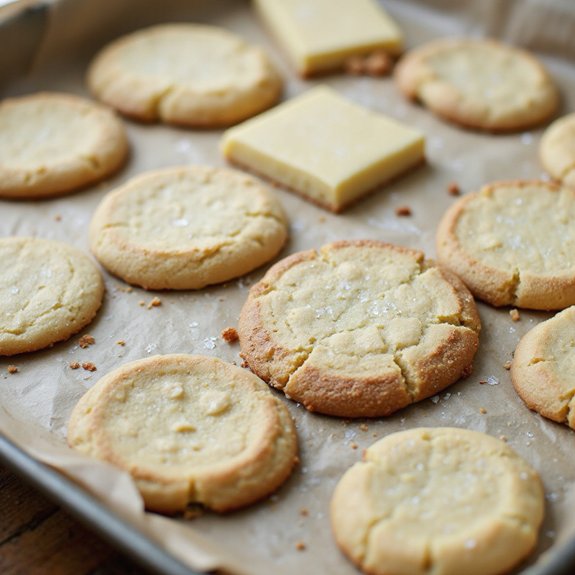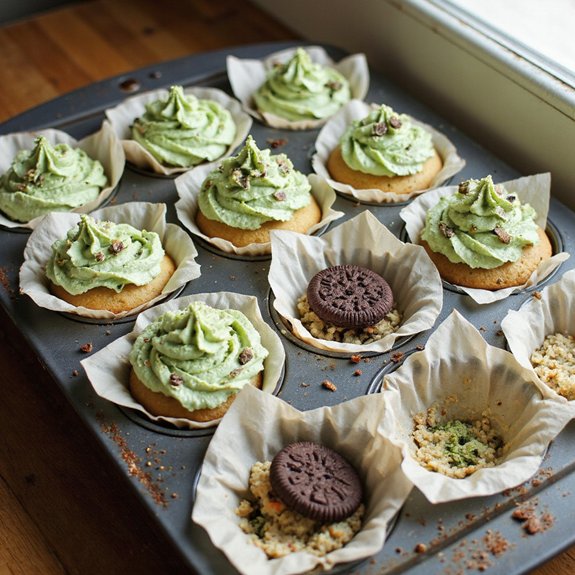Picture a tray of pale-gold cookies emerging from the oven, their sugar-dusted tops catching the light like fresh snow.
Imagine the buttery aroma filling your kitchen, the first bite giving way to a tender, sandy crumble that melts into whispers of vanilla and almond—comfort in its simplest form.
Shortbread matters to me because it feels like a pause button: a moment to breathe, to brew tea, to share something small and perfect.
These Chicago Shortbread Cookies bridge weekday chaos and weekend calm—equally at home on busy weeknights, tucked into lunchboxes, or set out after Sunday suppers with a pot of coffee.
When my kids’ school bake sale moved up a day, this recipe saved me—four ingredients from the pantry, no fuss, and they disappeared first from the table.
We’ll keep the method easy, the flavor big, and the edges neat and crisp.
Ready? Let’s cook!
Why You’ll Love It
- Delivers rich, buttery flavor with a hint of vanilla-almond
- Uses pantry staples for easy, reliable baking anytime
- Holds clean edges thanks to chill-and-bake method
- Offers cut-out or bar options for versatile presentation
- Freezes beautifully for make-ahead convenience
Ingredients
- 1 cup unsalted butter softened — use good-quality butter for best flavor
- 3/4 cup powdered sugar sifted — guarantees a smooth, tender crumb
- 1 teaspoon vanilla extract — pure extract for clean aroma
- 1/4 teaspoon almond extract optional — adds subtle bakery-style depth
- 2 cups all-purpose flour sifted — promotes delicate texture
- 1/4 teaspoon fine sea salt — balances sweetness
- 2 tablespoons cornstarch — boosts melt-in-mouth crumb
- 2 tablespoons granulated sugar for topping — light sparkle finish
- 1 tablespoon coarse sugar optional for topping — extra crunch and shine
Step-by-Step Method
Cream the Butter
Beat softened butter on medium speed until creamy and smooth, about 1 minute. Scrape the bowl. Aim for a satiny texture without melting the butter.
Properly creamed butter creates a tender, crumbly bite. Avoid warmth from hands or a hot kitchen. Keep ingredients cool to preserve structure and prevent spreading during baking.
Lighten with Sugar and Extracts
Add powdered sugar, vanilla, and optional almond extract. Beat until light and fluffy, about 2 minutes. Incorporate air, but avoid overbeating. Scrape the bowl to make certain even mixing.
The mixture should look pale and billowy. Balanced flavor here carries through the entire cookie, so measure extracts precisely.
Combine Dry Ingredients
Whisk flour, fine sea salt, and cornstarch in a separate bowl. Break up any clumps.
Even distribution of salt and cornstarch improves texture and flavor. Cornstarch softens the crumb and adds that classic shortbread snap. Keep the mixture dry and airy to prevent dense pockets in the finished dough.
Bring Dough Together
Add dry ingredients to the butter mixture. Mix on low just until a soft dough forms with no dry streaks. Stop as soon as it clumps.
Overmixing develops gluten and toughens the cookies. Finish folding with a spatula to catch flour at the bottom. The dough should feel soft and cohesive.
Chill the Dough
Divide dough into two discs. Wrap and chill for 20 minutes to firm slightly.
Chilling relaxes gluten and prevents spreading. It also makes rolling and cutting cleaner. If the dough feels sticky, chill a bit longer. Work with one disc at a time to keep the other cold and manageable.
Roll or Press
For cut cookies, roll a disc between parchment to 1/4-inch thickness. Cut shapes cleanly, rerolling scraps minimally.
For bars, press dough into a parchment-lined pan to 1/2-inch thickness and score. Dock bar dough with a fork to prevent bubbling. Keep edges even for uniform baking.
Sugar and Chill Again
Arrange cookies on parchment-lined sheets, spaced 1 inch apart. Sprinkle lightly with granulated sugar and optional coarse sugar for sparkle.
Chill the trays for 10 minutes to set edges. This step sharpens details on cut shapes and improves texture. Preheat the oven to 325°F (165°C) now.
Bake to Pale Gold
Bake 16 to 18 minutes until edges are pale golden and centers are set, not browned. Rotate sheets halfway for even color.
Shortbread should remain light. Overbaking dries and darkens the cookies. If making bars, watch corners closely. Remove when fragrant with just-blushed edges.
Cool and Finish
Cool on the baking sheets for 5 minutes to set. Transfer to a wire rack to cool completely.
For bar-style, slice while warm for clean edges, then let cool. Avoid moving too soon, as warm shortbread is fragile. Once cooled, store airtight. The flavor improves slightly by the next day.
Ingredient Swaps
- Butter: Use plant-based butter sticks (not tubs) for dairy-free; cultured European-style butter for richer flavor; or half butter/half coconut oil for a subtle coconut note.
- Flour: Swap up to 1 cup with rice flour or fine semolina for extra snap; use 1:1 gluten-free baking blend plus 1–2 teaspoons milk or water if dough seems dry.
- Sugar: Replace powdered sugar with superfine sugar (texture slightly crisper); maple or coconut sugar alters color/flavor—use 2/3 cup and expect deeper taste.
- Extracts: Almond extract is optional—swap with lemon, orange, or bourbon vanilla; add 1–2 teaspoons citrus zest for a bright twist.
- Cornstarch: Substitute equal amount of potato starch or tapioca starch; or omit and replace with flour (slightly less tender).
- Toppings: Use sanding sugar, demerara, or a sprinkle of cinnamon sugar for budget/regional variations; finish with sesame or crushed pistachios for a Middle Eastern nod.
You Must Know
- Doneness • If the bottoms look very pale but the centers feel dry to a light tap, leave them 1–2 more minutes; you want edges just turning pale gold and a sandy surface, not glossy. This keeps the crumb tender and avoids hard cookies.
- Troubleshoot • If shapes are spreading or edges look blurred at 6–8 minutes in, slide the tray onto a second, cool sheet and return for the remaining time. Doubling the pan insulates, curbing melt and preserving definition.
- Scale • For a double batch, weigh flour (240 g per cup; target 240 g × 2 = 480 g) and butter (227 g per cup; target 454 g) to maintain texture. Volume scooping can pack 10–20% extra flour, causing dryness.
- Flavor Boost • For a deeper “bakery” note, brown 2–3 tablespoons of the butter, chill to resolidify, then incorporate; or add 1/2 teaspoon finely grated lemon zest. You’ll get nutty or bright aromas without altering structure.
- Make-Ahead • To hold dough 24–72 hours, keep discs tightly wrapped at 36–40°F and let soften just until rollable (10–20 minutes). A cold, pliable dough yields cleaner cuts and sharper edges in the oven.
Serving Tips
- Serve with hot coffee or black tea to balance the buttery sweetness.
- Plate alongside fresh berries and a dollop of lightly sweetened whipped cream.
- Pair with vanilla ice cream; crumble warm shortbread on top for texture.
- Offer a trio: plain, chocolate-dipped, and citrus-zested wedges for variety.
- Present on a sugared platter; dust lightly with powdered sugar before serving.
Storage & Make-Ahead
Store baked shortbread in an airtight container at room temperature 1 week.
Or refrigerate up to 2 weeks for extra freshness.
The dough is great for make-ahead.
Chill discs tightly wrapped up to 3 days.
For longer storage, freeze dough or baked cookies up to 2 months.
Thaw before baking or serving.
Reheating
Reheat shortbread gently: microwave 5–10 seconds at 50% power.
Oven at 300°F for 4–6 minutes on a parchment-lined sheet.
Stovetop in covered skillet on low 2–3 minutes, avoiding browning.
WBEZ Pledge Drive Treats
Warm them gently if you like a just-baked feel, then let’s put these shortbread cookies to work as WBEZ pledge drive treats.
I pack them in neat stacks, edges glittering with fine and coarse sugar, so they catch the studio lights like tiny marquees.
The first bite snaps, then melts—buttery, vanilla-rich, with a whisper of almond—and suddenly the phones start ringing.
I portion them into brown paper sleeves, add a sticker—“Powered by Butter”—and set a plate by the host’s mic.
Volunteers smile, reach, and refuel between calls.
The cookies hold their shape, don’t crumble on the board, and taste like calm.
I keep a spare tin chilled, swapping in fresh batches during breaks.
They’re simple, sturdy, and irresistibly persuasive.
Final Thoughts
Ready to bake a batch? Give these Chicago Shortbread Cookies a try as written, or tweak them with your favorite extracts, citrus zest, or a sprinkle of coarse sugar for your own signature touch!
Frequently Asked Questions
Can I Make These Cookies Gluten-Free Without Gritty Texture?
Yes—you can. I swap in a fine 1:1 gluten-free flour with starches, add 1 teaspoon xanthan gum, and let the dough rest 20 minutes. The baked cookies taste buttery, tender, and sandy—not gritty.
What Altitude Adjustments Are Needed for Denver Baking?
Bake at 335°F, reduce sugar 1 tablespoon, add 1–2 teaspoons extra flour, and chill dough well. I watch edges: pale gold, set centers. I keep sheets ungreased, use parchment, and avoid overbrowning—Denver’s dry air speeds crisping.
How Do I Package Them for Mailing Without Crumbling?
Wrap each cookie snugly in parchment, stack in a tin with bubble-wrap cushioning, and pack the tin in a padded box. I add desiccant, fill voids with peanuts, label “Fragile,” and ship faster. You’ll hear crunch, not crumbs.
Which Mixer Attachment Yields the Flakiest Crumb?
Use the paddle attachment. I cream butter and sugar just until fluffy, then gently mix in dry ingredients. The paddle keeps streaks minimal, avoids overaeration, and yields that delicate, sandy crumble you’ll feel melt between your fingertips.
How Can Kids Safely Help at Each Step?
Kids can safely help by measuring, sifting, and whisking, then creaming butter with supervision. I’ll guide rolling between parchment, sprinkling sugars, and setting timers. I’ll handle oven tasks, hot trays, and sharp cutters, keeping little hands busy, proud, and safe.

Chicago Shortbread Cookies
Equipment
- 2 Mixing bowl
- 1 hand mixer or stand mixer
- 1 Whisk
- 1 Rubber spatula
- 1 Measuring cups set
- 1 Measuring spoons set
- 2 Baking sheet
- 2 parchment paper sheet
- 1 Wire rack
- 1 Rolling Pin optional
- 1 cookie cutter or knife optional
Ingredients
- 1 cup unsalted butter softened
- 3/4 cup powdered sugar sifted
- 1 teaspoon vanilla extract
- 1/4 teaspoon almond extract optional
- 2 cup all-purpose flour sifted
- 1/4 teaspoon fine sea salt
- 2 tablespoon cornstarch
- 2 tablespoon granulated sugar for topping
- 1 tablespoon coarse sugar optional, for topping
Instructions
- Preheat the oven to 325°F (165°C) and line two baking sheets with parchment paper.
- In a mixing bowl, beat the softened butter with a mixer on medium speed until creamy and smooth, about 1 minute.
- Add the powdered sugar, vanilla extract, and almond extract, and beat until light and fluffy, about 2 minutes.
- In a separate bowl, whisk together the flour, salt, and cornstarch until evenly combined.
- Add the dry ingredients to the butter mixture and mix on low just until a soft dough forms without dry streaks.
- Divide the dough in half, shape into two discs, and chill in the refrigerator for 20 minutes to firm slightly.
- For cut cookies, roll one disc between parchment to 1/4-inch thickness and cut shapes; for bars, press dough into a parchment-lined pan to 1/2-inch thickness and score.
- Arrange cookies on prepared sheets 1 inch apart, sprinkle lightly with granulated sugar and optional coarse sugar, and chill on the trays for 10 minutes.
- Bake for 16 to 18 minutes until the edges are pale golden and the centers are set but not browned.
- Cool on the baking sheets for 5 minutes, then transfer to a wire rack to cool completely.





